The Round Hill Society
The home site of the Round Hill Society, a community group of the residents of Round Hill in Brighton, England. The site contains information about the area, latest news and reflections on life in Round Hill.
Gardens and wildlife under threat
by Rob Stephenson Round Hill Reporter" December 2004
Mike Toms, of the British Trust for Ornithology, has said, “Collectively, gardens make up the best nature reserve we’ve got in this country.” Recent BTO research shows that gardens provide homes for over 300,000 pairs of song thrushes, and with good management this could be 500,000. But there are threats to urban wildlife, not least the trend for tidy gardens, making them extensions of indoor living spaces.
Paving, patios and decking; replacing tall trees and shrubs with neat flower beds and shorter perennial planting can all lead to starvation amongst young bird populations through a shortage of grubs and insects. Research at Sheffield University reveals that the strongest positive correlation with better wildlife is presence of trees and shrubs over two metres tall. The gentrification of gardens is also linked to the growth of garden pesticide use by 114% between 1997 and 2001, according to the Pesticides Action Network.
Ultimately we are all responsible for the quality of habitat we control: it’s no good depending on others to have trees and shrubs, good nectar plants, log piles and ponds. Until a few weeks ago the garden next door but one to me was a mass of brambles, trees and shrubs, offering nesting sites for blackbirds and shelter for small mammals and amphibians. The house has been refurbished and the garden almost entirely cleared, huge diversity replaced by new lawn, bare fence panels and a large area of bark chippings.
Government planning policy isn’t helping either, with a national target for 60% of new homes to be built on previously developed land, a definition which includes back gardens. In Round Hill we have lost open space to housing behind Belton Road and between Princes Road and Richmond Road, but in both cases some open space has been retained.
The latest threatened open space is between the railway and Prince’s Road. In 2001 young people, aided by then resident David Hodd, surveyed this piece of land for its wildlife. They recorded 63 different species, seen on the day or reported as regular visitors by residents, including foxes, hedgehogs, common newts, hawker dragonflies, frogs, hummingbird hawk moths and rufous grasshoppers. The wrong kind of development could lose us all of these species, but a modest and sensitive development could improve the habitat for these and many more creatures.
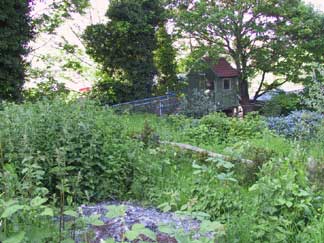
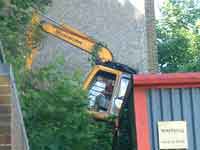
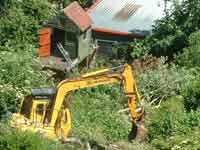
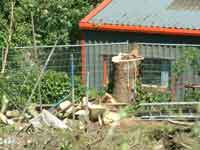
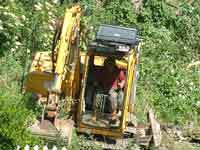
Of course no building at all, and active wildlife management, would be best for the habitat. According to a recent edition of Urbio, the English Nature urban wildlife magazine, many local authorities have wildlife policies that protect back-land areas behind houses – perhaps we should be looking for a proactive policy from our Council?
This page was last updated by Ted on 09-Nov-2013Mike Toms, of the British Trust for Ornithology, has said, “Collectively, gardens make up the best nature reserve we’ve got in this country.” Recent BTO research shows that gardens provide homes for over 300,000 pairs of song thrushes, and with good management this could be 500,000. But there are threats to urban wildlife, not least the trend for tidy gardens, making them extensions of indoor living spaces.
Paving, patios and decking; replacing tall trees and shrubs with neat flower beds and shorter perennial planting can all lead to starvation amongst young bird populations through a shortage of grubs and insects. Research at Sheffield University reveals that the strongest positive correlation with better wildlife is presence of trees and shrubs over two metres tall. The gentrification of gardens is also linked to the growth of garden pesticide use by 114% between 1997 and 2001, according to the Pesticides Action Network.
Ultimately we are all responsible for the quality of habitat we control: it’s no good depending on others to have trees and shrubs, good nectar plants, log piles and ponds. Until a few weeks ago the garden next door but one to me was a mass of brambles, trees and shrubs, offering nesting sites for blackbirds and shelter for small mammals and amphibians. The house has been refurbished and the garden almost entirely cleared, huge diversity replaced by new lawn, bare fence panels and a large area of bark chippings.
Government planning policy isn’t helping either, with a national target for 60% of new homes to be built on previously developed land, a definition which includes back gardens. In Round Hill we have lost open space to housing behind Belton Road and between Princes Road and Richmond Road, but in both cases some open space has been retained.
The latest threatened open space is between the railway and Prince’s Road. In 2001 young people, aided by then resident David Hodd, surveyed this piece of land for its wildlife. They recorded 63 different species, seen on the day or reported as regular visitors by residents, including foxes, hedgehogs, common newts, hawker dragonflies, frogs, hummingbird hawk moths and rufous grasshoppers. The wrong kind of development could lose us all of these species, but a modest and sensitive development could improve the habitat for these and many more creatures.





Of course no building at all, and active wildlife management, would be best for the habitat. According to a recent edition of Urbio, the English Nature urban wildlife magazine, many local authorities have wildlife policies that protect back-land areas behind houses – perhaps we should be looking for a proactive policy from our Council?